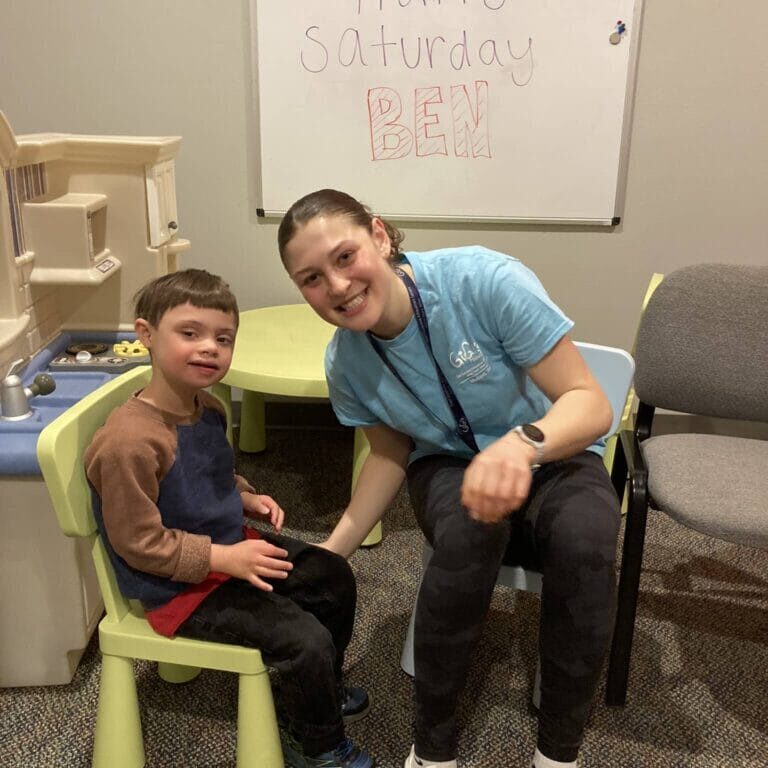Sensory Blog- Oral Sensory Processing
Oral Sensory Processing
Guest blog written by Occupational Therapy Assistant Student, Juliana Lehman OTAS
Advisement, Editing and Supervision by Deborah Bebeau EdD, OTR
 Does your child gag, turn away from or avoid most foods? Conversely, does your child seek out chewy or crunchy substances consistently throughout the day? If you answered yes to either of these questions, you have plenty of company.
Does your child gag, turn away from or avoid most foods? Conversely, does your child seek out chewy or crunchy substances consistently throughout the day? If you answered yes to either of these questions, you have plenty of company.
Children can be hyper-sensitive or under-responsive to oral stimuli (Cermac, 2010). It is estimated that 5-10% of typically developing children have a serious feeding disorder and up to 80% of children with developmental disabilities (Children’s Wisconsin, 2021). The oral-sensory aspect of eating requires the tissues of the mouth to perceive sensory information such as taste, temperature, and texture of food. Children can have challenges with any or all parts of the feeding process (Children’s Wisconsin, 2021).
Oral Sensory Sensitivity
Many children get the moniker of “picky eater” and the hope of most parents is that they will just grow out of it. A smaller appetite and hesitancy to try new foods can be in the range of normal childhood development. Our food palate does expand with age (Anil, 2019) and presents with some regard to family preferences, but early evaluation and intervention can help insure a varied nutritional diet and encourage certain responses at mealtimes (Curtin, 2015). Preferred food choices may in part be due to sensory sensitivities. These sensory sensitivities contribute to difficulties in an important activity of daily living, feeding and eating. The senses involved in eating are multi-fold, and the avoidance of oral stimulation may be a form of touch aversion (Cole, 2018). With oral defensiveness, avoidance of oral stimulation, a child may turn down foods with certain textures, because of how they feel in the mouth. Toothbrushing participation can also be difficult.
Children with Autism Spectrum Disorder (ASD) often display food selectivity because of sensory impairment or defensiveness (Leader, 2020). Smell can also affect eating choices. When children smell food that they cannot tolerate, it may inhibit them from eating. Children with Down Syndrome (DS) may have food selectivity because of low tone. This means that all musculature phases of swallowing are affected. The oral phase may present with tongue thrusting and not wanting to chew food. The preference may be sucking on food until it dissolves. This will cause food to lose any of the flavor it once had and delay swallowing. Tongue thrust, difficulties in chewing, poor lip closure, and choking can also contribute to difficulties when eating or feeding. The greatest difficulty eating safely is often moving from solid food to liquid (Bernhardt, 2019). Food can remain in the cheeks, or not be fully broken up and then swallowing a liquid happens too fast.
Potential Solutions:
- Use gum massage for oral stimulation: https://www.arktherapeutic.com/blog/gum-massage-for-oral-stimulation/
- Add oral activities into the daily routine such as blowing on whistles, blowing cotton balls or bubbles with a straw
- Try a fun vibrating toothbrush to provide oral sensory input that may help wake up the mouth (Lowsky, 2016)
Oral Sensory Seeking
Some children may be regarded as never appearing satisfied with enough oral stimulation, seeking chewy or crunchy substances throughout the day. These children may have an oral sensory need for input that can, especially during times of stress or anxiety, help calm, focus, and self-regulate (Lowsky, 2016). If under-responsive to oral stimulation, they may appear to put everything in their mouths, seeking an oral response. With oral under-responsiveness children may stuff their mouths way too full or put unhealthy or unsafe objects in their mouths. If you are noticing these behaviors in your child, begin a discussion with your child’s physician and then your therapy team. Ideally, the conversation will lead to specific behavioral explanations and potential solutions spelled out in a step-by-step manner. Your doctor might provide solutions such as seeing a dentist to rule out medical issues, gum massage, changing toothpaste, play with food, separate food on plate into sections, or have your child participate in pretend feeding of a stuffed animal. From here specialized therapists can implement a specific plan to address the behavior with parental involvement, teaching and implementation.
Potential Solutions:
1.Give them something safe to chew on: https://www.arktherapeutic.com/oral-motor-chewing-tools/
2. Add chewy and crunchy food to the child’s diet such as carrots, crackers, apples or foods with strong intense flavors such as lemons
3. Add vibration for increased stimulation:
https://www.arktherapeutic.com/arks-z-vibe-vibrating-oral-motor-tool/
Please remember that these are only some ideas and an in-person evaluation with a trained professional is recommended for the best treatment for YOUR child. Each child is very individual and specialist therapy may be necessary to make adaptations to diet or the eating process. Some possible parental choices include consultations and appointments with Healthcare professionals and Therapists, support from specialized community resources, adaptive technology implements, counseling services, and educational sources.
Healthcare Professionals may include:
- Occupational Therapists
- Physical Therapists
- Speech-Language Pathologists
- Audiologists
- Family Counseling Psychologists
Treatment Focus may include:
- Sensory Integration
- Sensorimotor Therapy
- Music Therapy
- Auditory Integration
- Applied Behavior Analysis
- Assistive Technologies such as oral-motor tools mentioned above
Community specialized resources and education sources may include:
- Parent Training Classes
- Parent Support Groups
- Sibling Support Groups
- Social Skills Training Groups
- Social Stories Education
Disclaimer: By referencing products or services this author does not directly or indirectly endorse any
specific product or services. This blog is for informational purposes only and is not intended to give
medical advice. Please consult with your child’s physician or licensed practitioner and consider the
individual needs of your child.
Blog Sources
Posted by Debra C. Lowsky, MS, CCC-SLP on 2nd Aug 2011
Oral defensiveness falls into two main categories: HYPOsensitivity and HYPERsensitivity
https://www.arktherapeutic.com/blog/oral-defensiveness-aversions/
https://www.misophoniainternational.com/wp-content/uploads/2015/09/SensoryDietAdultTeen.pdf
Cole, M. B. (2017). Group dynamics in occupational therapy (5th ed.). SLACK. Copy citation.
Cermak SA, Curtin C, Bandini LG. Food selectivity and sensory sensitivity in children with autism spectrum disorders. J Am Diet Assoc. 2010 Feb;110(2):238-46. doi: 10.1016/j.jada.2009.10.032. PMID: 20102851; PMCID: PMC3601920.
Leiva-García, B., Planells, E., Planells del Pozo, P., & Molina-López, J. (2019). Association Between Feeding Problems and Oral Health Status in Children with Autism Spectrum Disorder. Journal of Autism & Developmental Disorders, 49(12), 4997–5008. https://doi.org/10.1007/s10803-019-04211-w
Leader, G., Tuohy, E., Chen, J. L., Mannion, A., & Gilroy, S. P. (2020). Feeding Problems, Gastrointestinal Symptoms, Challenging Behavior and Sensory Issues in Children and Adolescents with Autism Spectrum Disorder. Journal of Autism & Developmental Disorders, 50(4), 1401–1410. https://doi.org/10.1007/s10803-019-04357
Curtin, C., Hubbard, K., Anderson, S., Mick, E., Must, A., & Bandini, L. (2015). Food Selectivity, Mealtime Behavior Problems, Spousal Stress, and Family Food Choices in Children with and without Autism Spectrum Disorder. Journal of Autism & Developmental Disorders, 45(10), 3308–3315. https://doi.org/10.1007/s10803-015-2490-x
Margari, L., Marzulli, L., Gabellone, A., & Giambattista, C. de. (2020). Eating and Mealtime Behaviors in Patients with Autism Spectrum Disorder: Current Perspectives. Neuropsychiatric Disease & Treatment, 16, 2083–2102. https://doi.org/10.2147/NDT.S224779
Ross, C. F., Bernhard, C. B., & Smith, S. S. (2019). Parent‐reported ease of eating foods of different textures in young children with Down syndrome. Journal of Texture Studies, 50(5), 426–433. https://doi.org/10.1111/jtxs.12410
Anil, M. A., Shabnam, S., & Narayanan, S. (2019). Feeding and swallowing difficulties in children with Down syndrome. Journal of Intellectual Disability Research, 63(8), 992–1014. https://doi.org/10.1111/jir.12617
Versaci, T. M., Mattie, L. J., & Imming, L. J. (2021). Down Syndrome and Autism Spectrum Disorder Dual Diagnosis: Important Considerations for Speech-Language Pathologists. American Journal of Speech-Language Pathology, 30(1), 34–46. https://doi.org/10.1044/2020_AJSLP-20-00050
Neil, N., Fiani, T., Mannion, A., & Lynch, M. (2018). Exploratory, Pilot Study: Treatments Accessed by Caregivers of Children with Down Syndrome – An Internet Survey. Journal on Developmental Disabilities, 23(2), 37–49.
Recent Posts





